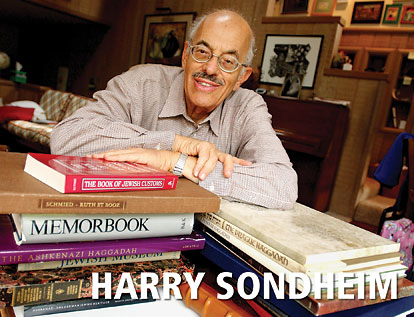HOW I GOT STARTED
Harry Sondheim

Harry Sondheim will be part of a panel discussing “Collecting
Your Roots at the California International Antiquarian Book Fair to be held
in Los Angeles February 17–19 For the time and date and the names
of the other panelists visit www.labookfair.com.
Jewish customs and ceremonies
In the early 1970s, my wife (who passed away last year)
and I visited Amsterdam and went to the Weigh House, which housed the Jewish
Historical Museum at the time. In one half of the building there was an
exhibition on the Holocaust. The other half was devoted to the contributions
Jews made to the Netherlands. That exhibit included a series of pictures
by Bernard Picart, a French engraver who worked in Amsterdam. The images
were from his book Cérémonies et coutumes religieuses de tous
les peuples du monde [Religious Ceremonies and Customs of All the Peoples
of the World], which included many depictions of Jews in various ceremonies
like Passover and weddings.
I bought some postcards of Picart’s prints,
and when I came back to Los Angeles, I went to Jake Zeitlin’s shop.
I showed him the Picart postcards and asked if he had any of the prints.
He didn’t. About two weeks later, he called to say that someone had
just come in to sell a bunch of Picart prints. He offered them to me and
I ended up buying them all. And that’s how I got started.
I began to collect depictions of Jewish customs
and ceremonies, generally before 1920, and the work of Arthur Szyk, which
is a bit later. I liked the concept of these customs having a long history,
and it’s interesting to see how different artists depicted them. Some
of the plates were used over and over again in different books. I’m
not generally interested in getting all the editions of a particular plate.
I’m more interested in getting depictions I don’t have.
I don’t collect biblical illustrations because
we don’t have any original art from that time. I also don’t
collect anti-Semitic works. I’m not interested in pogroms. I’m
more interested in things that are accurate or reasonably accurate. There
is an exception, however. Johann Pfefferkorn was a Jew who converted to
Christianity and wrote a very anti-Semitic work in 1508 that happens
to depict Jewish customs.
I have some Haggadahs, too. When we have our holiday
of Passover, we read from a Haggadah, a book that tells of the Jews in Egypt
and the exodus from slavery. Many Haggadahs are illustrated, and I like
them because they represent the spirit of freedom.


